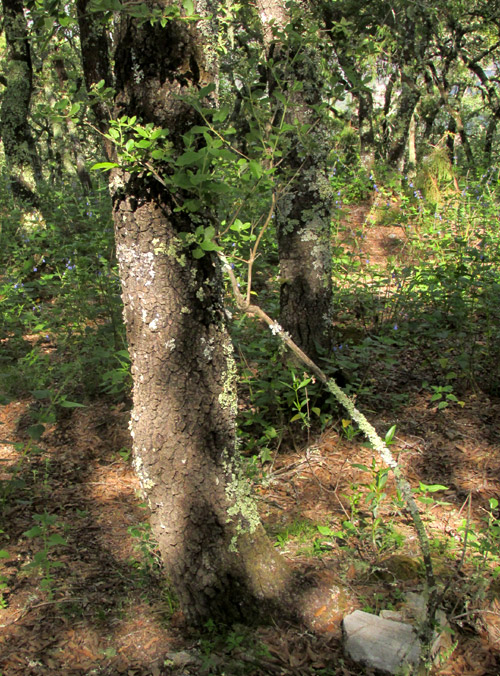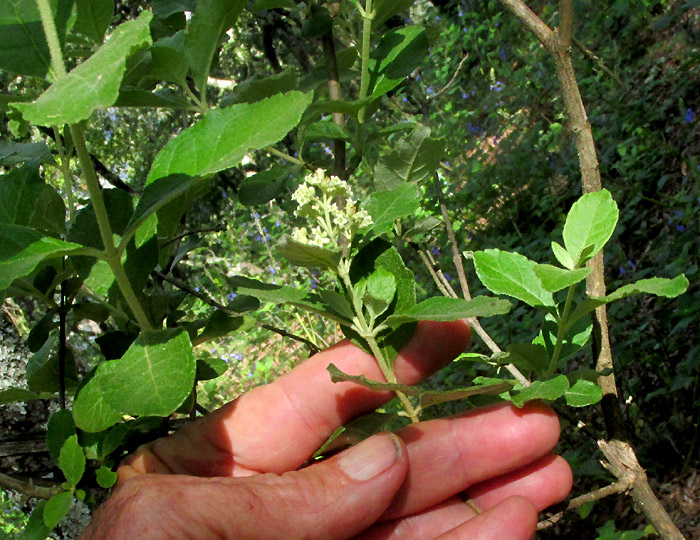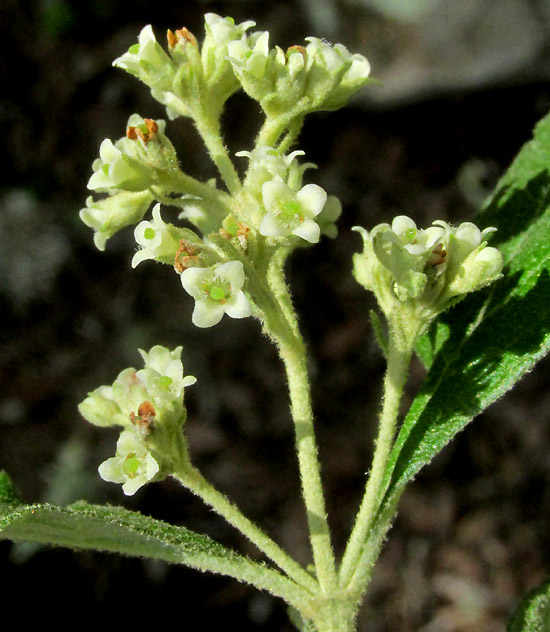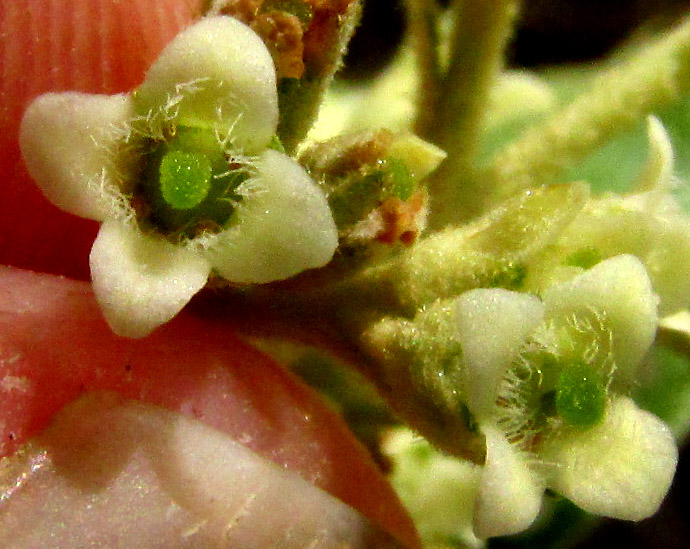Excerpts from Jim Conrad's
Naturalist Newsletter
Entry from field notes dated September 1, 2023, taken in Los Mármoles National Park in the Eastern Sierra Madre mountains, Hidalgo state, MÉXICO, forested ridge near fork in road leading to Puerto de Piedra, on road between town of Trancas {on maps designated "Morelos (Trancas)"} and Nicolás Flores; oak/pine forest on limestone bedrock; elevation ~2,300m (~7,550ft); ~N20.80°, ~W99.24°
TEPOZÁN BUTTERFLYBUSH

On a forested ridge sometimes grazed by roaming cattle, a scraggly understory small tree bent toward the trunk of an oak, Quercus laurina, maybe searching for more sunlight, or maybe once stepped on and deformed by a wandering cow. It gave the impression of having grown slowly, stunted by shade or old wounds.

The stems bore pairs of simple leaves at each node, the blades bearing no lobes and only hints of low, blunt teeth along their margins. A couple of stems were tipped with inflorescences of white flowers:

The inflorescences were panicle-type -- branched with branches -- and the branch stalks were densely covered with white hairs. Even the inside faces of corolla lobes were bearded with white hairs:

The white hairiness was most conspicuous, however, on this year's stems and the undersurfaces of new leaves, though much diminished on the blades' green upper surfaces:

Having a woody bush with paired, simple leaves at stem nodes, panicles of small, four-lobed flowers showing outsized, knobby stigmas, and stems and stalks thickly hairy with white hairs, it's clear that we're dealing a familiar group. It's yet another of those shrubs and small trees known to English speakers as butterflybushes, though that name is applied to several kinds of pollinator-attracting garden plants. It's another species of the genus Buddleja, which currently is assigned to the Snapdragon-Digitalis-Figwort Family, the Scropulariaceae. You might enjoy seeing other variations on the Buddleja theme with our earlier-seen Buddleja scordioides, Buddleja sessiliflora and Buddleja cordata.
The 2021 work by José Luis Villaseñor and others entitled "Riqueza y distribución de la flora vascular del estado de Hidalgo, México" lists six Buddleja species occurring in our upland central Mexican state of Hidalgo. Of those, if your flowers are white and arranged in panicles, not spikes, and if the insides of the corolla lobes are conspicuously hairy, you have BUDDLEJA PARVIFLORA, known by no commonly used English name other than butterflybush, which is used for all the species. In Spanish it's one of several Buddleja usually called tepozán.
Buddleja parviflora is widely distributed and fairly common throughout Mexico's uplands, south into Guatemala. Mainly it turns up in various highland forests which have been disturbed, which is nearly all of them. This is yet another species introduced to science by the collections of Humboldt and Bonpland during their visit to Mexico in 1802 and 1803. Their collected specimen was annotated, "in montosis prope urbem Cuernavaca" -- in mountains near the city of Cuernavaca.
Another indication that our little tree may be stunted by shade or cattle damage is that sometimes it reaches 7m tall (23ft).
The online Atlas de las Plantas de la Medicina Tradicional Mexicana reports that the plant is used in traditional medicine to treat swellings, sinus infections, for washing after giving birth, muscle pain, headache, and tiredness. However, few clinical studies have dealt specifically with Buddleja parviflora, other than to find that the species produces flavonoids and other compounds often found to be of therapeutic use.
Similarly, Buddleja parviflora isn't spoken of as particularly important for pollinators, but all the butterflybushes are recognized as such. The 2021 study by Jerónimo Reyes Santiago and others entitled "Catálogo de especies nativas Viveros Yecapixtla y Nezahualcóyotl" tells us that Buddleja parviflora hosts the colorful larval stage of Phassus triangularis, which is a moth. The tasty and highly nutritious caterpillar is eaten in Veracruz state's Sierra de Zongolica, as well as used medicinally to treat candidiasis, a yeast infection of the mouth. The authors also remind us that crickets rest beneath and sing from below these bushes.